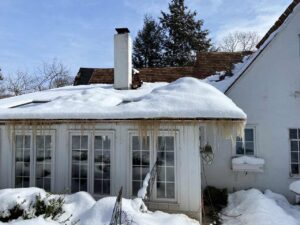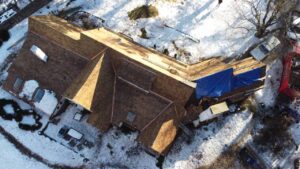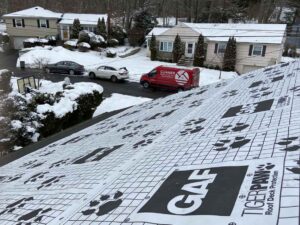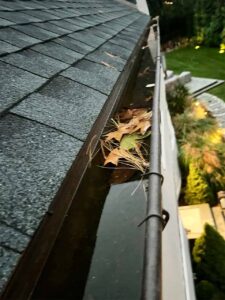It’s that time of year again! As the weather gets colder, it’s important to take some time to prepare your roof for winter.
Snow and ice can damage your roof and lead to leaks, plus the weight of snow and ice can also cause structural damage to your roof.

Accumulating snow and ice can cause roof damage
A little bit of preventative maintenance on your part before winter weather can save you a lot of money and headaches down the road. Here are some tips from us to help you get started:
Having your roof professionally inspected before the winter season begins is the best thing you can do
This can help identify any potential problems that need to be addressed, whether they are obvious or hidden. You can trust that Gunner Roofing will make sure the roof is structurally sound before that first winter storm arrives. Cold weather is unforgiving.

Gunner provides free roof inspections
Inspect your roof for any damage that may have occurred over the summer
Look for any loose or missing shingles, and repair or replace them as necessary. The summer months can take their toll on your roofing. For instance, the heat can cause the shingles to deteriorate, while the UV rays can damage the integrity of roofing materials. One thing that’s a must: Any new shingles installed or repairs made should be done correctly and be airtight.

Gunner uses GAF Tiger Paw for protection from the elements

GAF offers premium Tiger Paw roof deck protection
Clean out your gutters and downspouts to ensure that they are free of leaves and other debris
In an Architectural Digest interview, Gunner’s own Andrew Prchal stresses the importance of keeping your gutter system free and clear. That’s because if water is improperly diverted, the spillover splashing can cause mold, mildew, and other damage to your home. When your gutters are clear, water will flow freely through them and not back up onto your roof, which also helps prevent ice dams from forming. Ice dams occur when melting snow refreezes at the edge of your roof, creating a dam that prevents further melting snow from draining off your roof. This can lead to serious damage to your shingles and even leaks in your roof.

Keeping gutters free of leaves and debris prevents damage to your home
Trim back any tree branches that are hanging over your roof
These can cause damage if they fall during a winter storm. When moisture on branches freezes, the weight can cause the wood to break off and fall.
Apply a coat of weatherproofing sealant to any exposed areas of your roof
This will help protect against leaks. Water that penetrates your home through the roof can cause serious and expensive damage. Be sure to monitor walls and ceilings for water stains or discoloration. Those are typically signs that you have a leak somewhere in your roofing. There are many types of weatherproofing sealants out there, including silicone, acrylic sealant, asphalt-based, and urethane. Factors to consider include your type of roof, climate, and budget.
If you have a chimney, make sure that it is free of leaves and other debris as well
Check the flashing around your chimney and vent pipes to make sure it is secure. Flashing is the thin strip of aluminum or other material used to cover and seal the joints of roofing material (usually around chimneys, skylights, and other openings in the roof) to prevent water leaks. Also, a chimney with debris in it can be a fire hazard, regardless of season.
Inspect your roof for any signs of animal nesting
This is also another reason to make sure tree branches are cut back and your gutters cleared. Animals often use branches and shrubs as bridges to get to your roof, and clogged gutters can provide a perfect nesting space. In addition to possibly causing major damage to your roofing materials, these issues can also be a fire hazard if left unchecked.
Make sure that your attic is properly ventilated to help prevent ice dams from forming
Ventilation and insulation are key to keeping your attic squared away throughout the winter. Check that there is adequate insulation to keep heat from escaping through the roof. In addition to preventing ice dams, it will help keep your energy bills lower. Clear vents provide a way for air to circulate under your roof and help prevent moisture buildup.
It pays to be proactive
Following these tips will help you prepare your roof for the cold weather and those winter storms. Be sure to keep an eye on your roof throughout the season and make repairs as necessary. Doing preventative due diligence will pay yourself back when that first winter storm comes and through the long stretch of cold in the winter months.
If you have any questions or need assistance preparing your roof for winter weather, please contact Gunner Roofing. We’re always happy to help keep you warm!